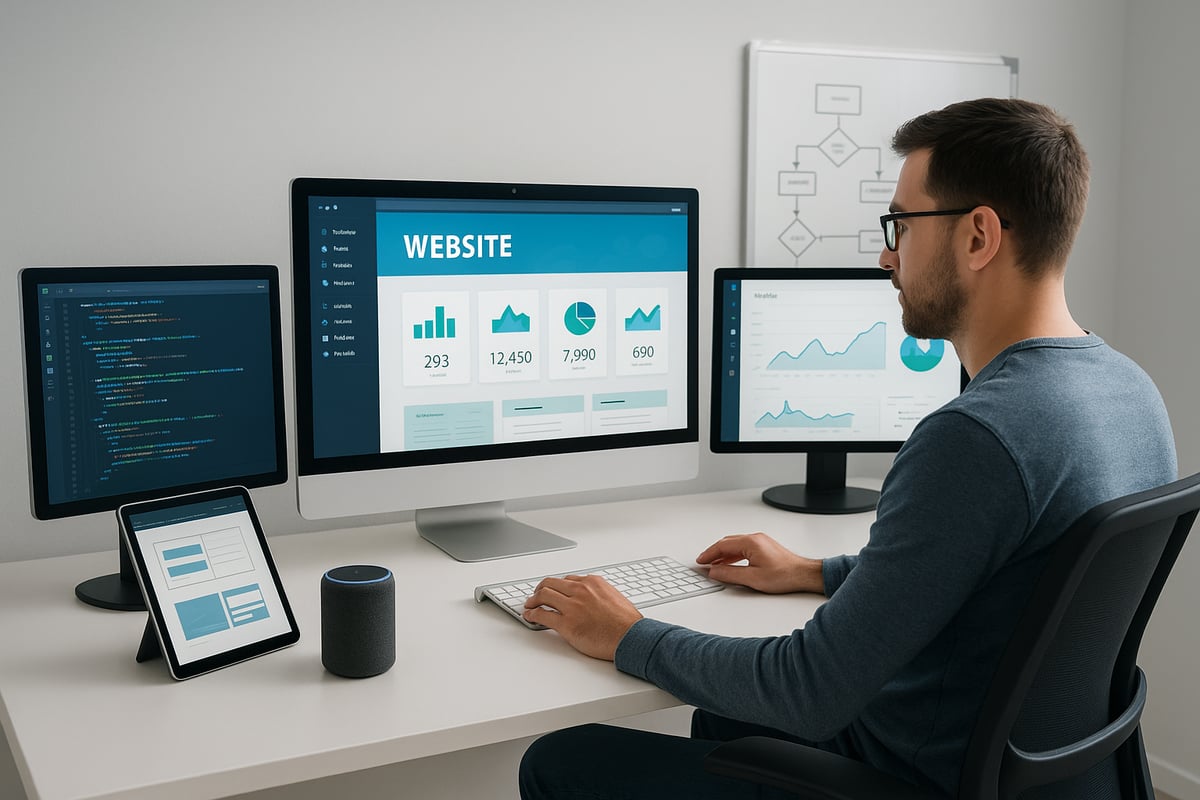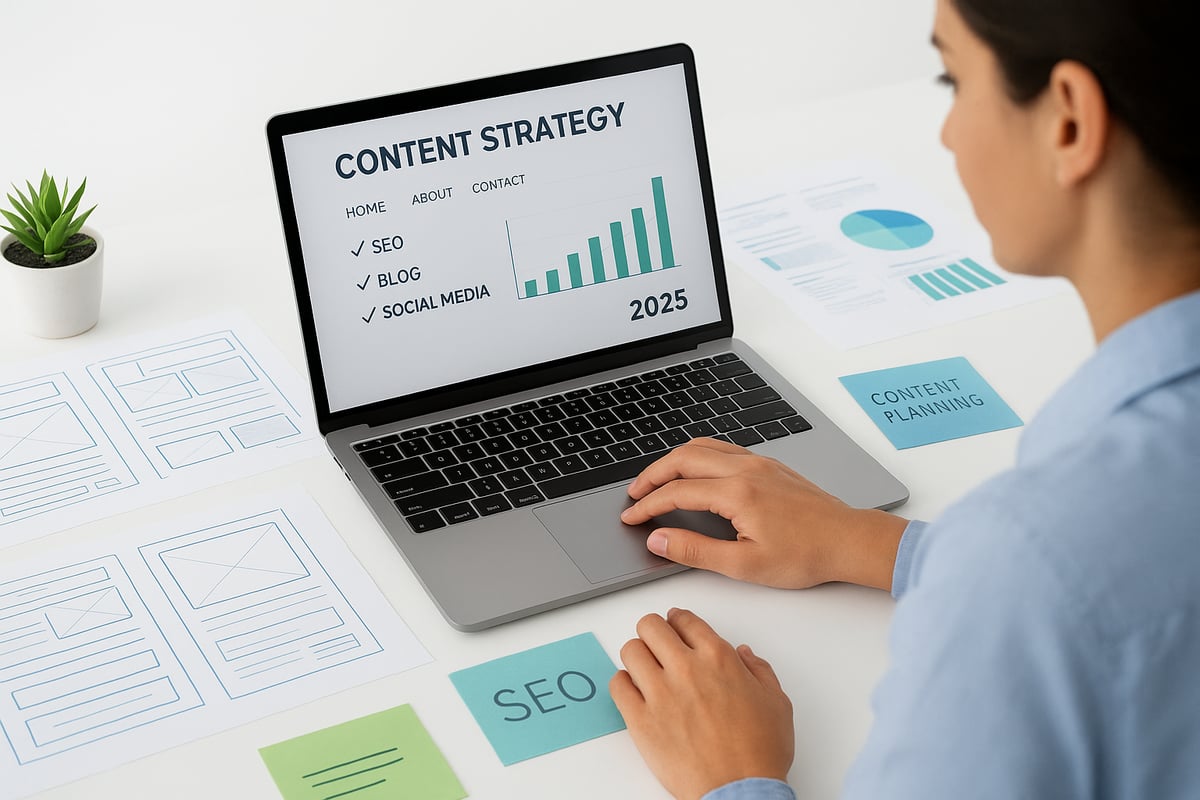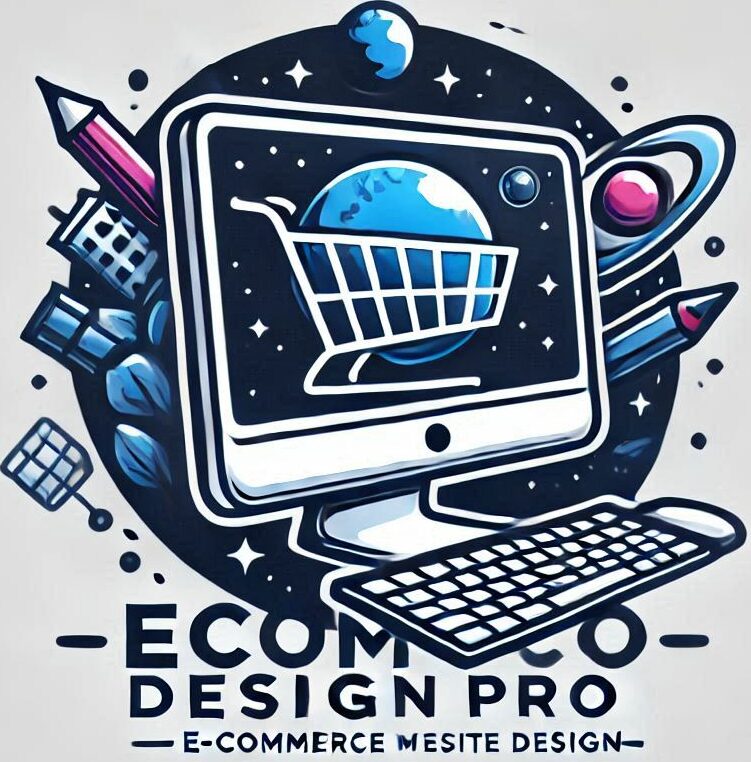As 2025 approaches, the pace of change in web design is accelerating, making it vital to keep your web design strategy ahead of the curve. New technologies and rising user expectations are reshaping what makes a website truly exceptional. Today, user experience, AI integration, and sustainability are no longer optional, but essential for online success. By mastering the core steps of your web design process, you set your business up for growth and resilience. This guide delivers a clear, step-by-step approach to building future-proof websites, covering planning, UX/UI, technology, content, optimization, and emerging trends.
Step 1: Strategic Planning for 2025 Web Design
Strategic planning is the foundation of your web design journey for 2025. With technology evolving quickly, businesses must be intentional about every decision. A strong plan ensures your website not only meets today's standards but is also ready for tomorrow's challenges.

Defining Your Website’s Purpose and Goals
Start by clarifying the primary objectives of your web design project. Are you aiming to increase sales, capture leads, or build brand awareness? Each goal shapes your site's structure and functionality.
Identify clear KPIs to measure success, such as conversion rates, bounce rates, or time on site. For example, an e-commerce business may set a goal to increase checkout conversions by 20 percent.
| Objective | KPI Example |
|---|---|
| Sales | Conversion Rate |
| Lead Generation | Form Completion Rate |
| Brand Awareness | Average Session Time |
Aligning your web design with business growth strategies is crucial. According to competitor data, 72 percent of successful sites begin with defined goals. Your web design should always support your broader business ambitions.
Audience Research and Persona Development
Understanding your audience is at the heart of effective web design. Conduct market research to learn about user needs, behaviors, and preferences. Use analytics platforms and surveys to gather data directly from your visitors.
Develop detailed user personas representing your ideal customers. For instance, if your web design targets Gen Z shoppers, prioritize mobile-first layouts and fast-loading content.
Personalizing your web design based on real user insights drives engagement and loyalty. User-centric planning ensures your site resonates with its intended audience and creates lasting connections.
Competitor Analysis and Industry Benchmarking
Staying ahead in your web design process means knowing what your competitors are doing. Analyze their websites for strengths, weaknesses, and opportunities to differentiate. Tools like SEMrush and SimilarWeb help benchmark your site's performance against industry leaders.
Study leading brands’ checkout flows, navigation, and content strategies. This approach inspires innovation and helps identify trends. In fact, 65 percent of designers use competitor analysis to fuel new ideas. For more on how industry trends are shaping digital projects, see the State of Digital Marketing Web Design in 2025.
Learning from others ensures your web design is both current and competitive.
Budgeting and Resource Allocation
Proper budgeting is essential for a sustainable web design project. Determine your total budget early, then allocate resources for design, development, content, and ongoing maintenance.
Decide whether to use in-house talent, hire an agency, or work with freelancers. Remember to reserve funds for post-launch optimization—many recommend allocating about 20 percent for this stage.
Smart budgeting in your web design process prevents costly surprises and reduces the risk of expensive redesigns. Plan resources carefully to keep your project on track and future-proof.
Project Timeline and Workflow Planning
Establishing a clear timeline is key to delivering your web design project on schedule. Break the process into milestones and set realistic deadlines for each phase.
Use project management tools like Trello or Asana to organize tasks and assign responsibilities. Define roles for each stakeholder to ensure accountability. Adopting agile methods allows for iterative progress and flexibility.
A structured workflow improves on-time delivery by 30 percent, according to industry insights. Keeping your web design project well-organized helps your team adapt quickly and achieve results efficiently.
Step 2: User Experience (UX) and User Interface (UI) Excellence
To make your web design stand out in 2025, focusing on both user experience (UX) and user interface (UI) is essential. A seamless experience not only delights visitors, but also drives engagement and conversions. Each of the following steps will help ensure your web design is accessible, responsive, intuitive, and consistently on-brand.

Designing for Accessibility and Inclusivity
Accessibility is a cornerstone of your web design strategy. Begin by implementing WCAG 2.2 guidelines, which include using high-contrast color schemes, readable fonts, and providing descriptive alt text for images. This makes your web design usable for everyone, including users with visual or motor impairments.
Consider these best practices:
- Ensure keyboard navigability for all site features.
- Provide sufficient color contrast for text and backgrounds.
- Use ARIA labels for assistive technologies.
For example, platforms like Airbnb set a benchmark with accessible booking flows. Since 1 in 4 adults lives with a disability, accessibility expands your web design reach and builds lasting trust.
Mobile-First and Responsive Design Strategies
A mobile-first approach is non-negotiable for your web design as mobile traffic continues to rise. Start with mobile layouts before scaling up for tablets and desktops. Responsive frameworks like Bootstrap or Tailwind CSS help maintain consistency across devices.
- Prioritize touch-friendly navigation elements.
- Optimize images and media for fast mobile loading.
- Test layouts on multiple screen sizes.
Shopify is a prime example, offering mobile-optimized storefronts that convert visitors into buyers. For a detailed guide to mobile usability in your web design, explore Mobile-First E-Commerce Design Strategies.
Intuitive Navigation and Site Architecture
Easy navigation is vital for your web design. Structure menus logically to guide users through your content. Use clear calls-to-action (CTAs) and breadcrumbs so visitors always know where they are.
Best practices include:
- Group similar pages under intuitive categories.
- Place primary navigation at the top or side for visibility.
- Use persistent navigation bars for seamless browsing.
Amazon’s persistent navigation bar is a proven way to keep users engaged. Streamlined navigation in your web design reduces bounce rates and increases user satisfaction.
Visual Hierarchy and Branding Consistency
Maintaining a strong visual hierarchy in your web design ensures users know where to focus. Use consistent color palettes, typography, and brand imagery throughout your site. Whitespace and strategic placement of elements help guide attention to the most important features.
Tips for consistency:
- Stick to a limited set of brand colors.
- Use heading sizes and font weights to indicate importance.
- Incorporate your logo and brand visuals on every page.
Apple stands out with minimalist, cohesive design. This approach in your web design enhances brand recall and creates a memorable experience.
Microinteractions and Animation for Engagement
Microinteractions add a layer of engagement to your web design. Subtle animations, hover effects, and loading spinners provide feedback and delight users. These small touches can make navigation feel intuitive and enjoyable.
Consider adding:
- Button hover effects for interactivity.
- Animated transitions between pages or sections.
- Playful loading animations to reduce perceived wait times.
Slack’s animated loading screens are a great example. Well-designed microinteractions can increase session duration and keep users coming back to your web design.
User Testing and Iterative Improvement
Continuous user testing is the backbone of effective web design. Conduct usability tests with real users to uncover pain points and opportunities for improvement. Tools like heatmaps and session recordings offer valuable insights.
Key steps include:
- Run A/B tests on layouts and CTAs.
- Collect feedback through surveys or interviews.
- Analyze user journeys for friction points.
High-performing websites make user testing a regular part of their web design process. Iterative improvements based on real data ensure your web design evolves to meet changing user expectations.
Step 3: Leveraging Modern Technologies and Tools
Staying ahead in your web design means making strategic technology choices. In 2025, the right tools, frameworks, and innovations will set successful websites apart from the crowd. Let us explore the essential steps to future-proof your web presence.

Selecting the Right CMS and Tech Stack
Choosing the right foundation for your web design is critical. Content management systems (CMS) like WordPress, Shopify, and Webflow each offer unique advantages. Your web design should match your business needs for scalability, security, and customization.
Here is a quick comparison:
| CMS | Best For | Customization | Security | Scalability |
|---|---|---|---|---|
| WordPress | Content-rich sites | High | Good | Excellent |
| Shopify | E-commerce | Medium | Excellent | Great |
| Webflow | Design flexibility | High | Good | Good |
For example, Shopify is ideal for e-commerce, while WordPress powers 43% of the web due to flexibility. Always match your web design platform to your goals and future growth.
Integrating Artificial Intelligence and Automation
AI is transforming your web design by enabling smarter, data-driven experiences. Incorporate AI chatbots for customer support, automate lead capture, and use personalization engines for dynamic content.
For e-commerce, AI-driven product recommendations can boost conversions by up to 20 percent. Discover more about AI-powered personalization in e-commerce to understand how automation can elevate your web strategy.
Embracing these technologies ensures your web design delivers both efficiency and engagement.
Enhancing Site Performance and Speed
Fast-loading websites are essential for your web design success. Optimize images, compress files, and use lazy loading techniques to speed up delivery.
Use a code snippet like this for lazy loading images:
<img src="image.jpg" loading="lazy" alt="Optimized image">
Leverage CDNs and select efficient hosting. Google’s PageSpeed Insights can help audit performance. Remember, sites loading in under 2 seconds see a 15 percent higher conversion rate, so prioritize speed in every aspect of your web design.
Ensuring Security and Data Privacy
Your web design must prioritize user trust. Secure your site with SSL certificates and HTTPS protocols. Use secure payment gateways and comply with regulations such as GDPR and CCPA.
Consider adding two-factor authentication for user accounts. With 82 percent of consumers ready to leave a site over security concerns, robust protection is non-negotiable in your web design process.
Regular security audits and privacy updates are vital for long-term reputation.
Future-Proofing with Scalable Architecture
Building for the future means your web design should be modular and adaptable. API-driven architectures, such as headless CMS, support easy integration of new technologies.
Migrating to Jamstack, for example, allows for flexibility and speed. Scalable sites can quickly adapt to market changes, ensuring your web design remains relevant.
Plan for ongoing updates and seamless integrations, so your web design stays ahead as trends and technologies evolve.
Step 4: Content Strategy and SEO Optimization
A robust content strategy is the backbone of your web design, directly influencing visibility, engagement, and conversions. In 2025, aligning content with search intent and SEO best practices is crucial for standing out in a competitive digital landscape. Below, discover how to elevate your web presence with a future-focused approach to content and optimization.

Crafting Compelling, Purpose-Driven Content
Effective content is at the heart of your web design, guiding users to take meaningful action. Begin by identifying user needs and business objectives, then tailor your messaging to address both. Storytelling adds authenticity, helping visitors connect emotionally with your brand.
Consider incorporating a variety of formats, such as case studies, customer testimonials, and FAQ sections. This diversity not only builds trust but also encourages longer site visits. Remember, every piece of content should serve a clear purpose within your web design, supporting both user journeys and conversion goals.
Keyword Research and On-Page SEO Best Practices
Keyword research is essential for ensuring your web design reaches the right audience. Use advanced tools like Ahrefs or SEMrush to identify high-value keywords relevant to 2025 trends. Optimize each page’s titles, headers, and meta descriptions with these terms, seamlessly weaving them into your content.
For additional inspiration, reviewing Web Design Trends to Watch in 2025 can help you align your web strategy with emerging search behaviors. Structuring your web pages for featured snippets and voice search will help your web design stand out in search engine results.
Structured Data and Schema Markup
Implementing structured data is a game-changer for your web design’s SEO. Schema markup helps search engines better understand your content, enabling rich results like FAQs, product details, and event listings. Use JSON-LD format for easy integration and future-proofing.
| Schema Type | Use Case |
|---|---|
| Product | E-commerce sites |
| Recipe | Food blogs |
| FAQ | Customer support |
| Article | News, blogs |
Sites with schema markup enjoy higher click-through rates, making it a smart investment for your web design in 2025.
Visual Content: Images, Video, and Interactive Media
Visual content is a powerful driver of engagement in your web design. High-quality images and videos capture attention and convey information quickly. Optimize all media with descriptive alt text and concise captions to enhance both SEO and accessibility.
Consider integrating interactive elements, such as product demos or 360-degree views, to immerse users in your brand experience. Video content, in particular, is proven to significantly increase dwell time, making it an essential component of your web design strategy.
Content Accessibility and Localization
Ensure your web design is accessible to all users, regardless of ability or location. Use clear language, logical headings, and adequate color contrast. Translate content into different languages to reach global audiences, adapting cultural references where appropriate.
Providing multilingual support demonstrates inclusivity and helps your web design succeed in new markets. Accessibility and localization are not just compliance measures—they are growth opportunities that build trust and increase conversions.
Building Authority with Link-Building and Content Partnerships
Link-building remains a cornerstone of SEO success for your web design. Pursue guest posting opportunities, form partnerships with industry influencers, and seek out backlinks from reputable sources. Participate in expert roundups and publish interviews to showcase thought leadership.
High-quality backlinks boost your site’s credibility and visibility in search results. By consistently building authority, your web design will attract organic traffic and foster long-term online success.
Step 5: Optimization, Analytics, and Continuous Improvement
In 2025, ongoing optimization is the backbone of your web design success. Focusing on analytics, conversion strategies, and continuous improvements ensures your site not only launches strong but stays ahead of competitors. This step-by-step approach helps you adapt to changing user needs and industry standards.
Setting Up Analytics and Tracking Tools
Begin by implementing robust analytics tools to measure the impact of your web design. Google Analytics 4 and Search Console are essential for tracking user journeys, conversions, and drop-off points.
Set up custom dashboards to monitor critical KPIs, such as bounce rate and session duration. Use event tracking to see which site features drive the most engagement. For e-commerce, funnel analysis reveals where customers abandon carts, giving actionable insights for improvement.
A data-driven approach empowers your web design to evolve based on real user behavior. This foundation supports ongoing optimization and smarter business decisions.
Conversion Rate Optimization (CRO) Techniques
Optimizing your web design for conversions requires a blend of strategy and experimentation. Begin with A/B testing headlines, CTAs, and layouts to see what resonates with your audience.
Use urgency triggers, such as limited-time offers or stock countdowns, to encourage action. Streamlining the checkout process can significantly reduce friction and boost sales. Did you know that CRO can deliver an average ROI of 223 percent?
For deeper insights, explore E-commerce UX Design Essentials to refine user flows and maximize conversions in your web design. Every small tweak can make a measurable difference.
Performance Monitoring and Page Speed Audits
Website speed is a critical factor in your web design strategy. Regularly audit your site using tools like GTmetrix and Lighthouse to identify bottlenecks.
Compress images, minify scripts, and leverage browser caching for faster load times. Even a one-second delay can reduce conversions by 7 percent, so every improvement counts. Create a schedule for routine performance reviews and address issues promptly.
A fast, efficient site not only delights users but also boosts search rankings, making performance a non-negotiable part of your web design optimization plan.
Personalization and User Segmentation
Personalization elevates your web design by delivering experiences tailored to each visitor. Segment users based on demographics, interests, and purchase history using analytics data.
Dynamic content and product recommendations keep users engaged and increase sales. Personalized sites consistently see a 19 percent uplift in revenue. Consider integrating behavioral triggers, such as targeted pop-ups or email follow-ups, to nurture relationships.
By understanding your audience segments, your web design becomes a powerful tool for building loyalty and driving growth in a competitive landscape.
Iterative Design and Continuous Deployment
Adopt an agile mindset for your web design projects. Use version control and staging environments to roll out updates safely and efficiently.
Collect ongoing feedback from users, then prioritize improvements based on real-world data. Continuous deployment ensures new features and optimizations reach your audience quickly. This approach keeps your web design aligned with the latest trends and user expectations.
Staying adaptable is key to long-term success, allowing your site to thrive as technologies and preferences evolve.
Step 6: Adapting to 2025 Web Design Trends and Future-Proofing
Staying ahead in your web design strategy means constantly evolving. As 2025 approaches, the digital landscape is shifting rapidly. To ensure your web design remains future-proof, it's essential to adopt emerging trends and new technologies. Each of the following areas will help position your web presence for long-term success.
Embracing AI-Driven Personalization and Automation
AI is transforming your web design approach, making it smarter and more efficient. Automated content generation, user behavior tracking, and dynamic personalization are now essential features. For instance, AI tools can suggest design improvements or create tailored experiences based on real-time data. This enables your web design to adapt instantly to user needs, driving engagement and conversions.
Personalization engines, chatbots, and automated workflows are projected to become even more vital by 2025. Integrating these solutions ensures your web design is not only modern but also responsive to shifting user expectations. AI adoption is forecasted to grow by 35 percent, so now is the time to invest in intelligent automation.
Sustainable and Eco-Friendly Web Design
Sustainability is becoming a core pillar in your web design priorities. Choosing green hosting providers and optimizing for lower energy consumption helps reduce your website's carbon footprint. Lightweight design and efficient code contribute to eco-friendly performance.
For businesses aiming to stand out, eco-conscious practices can be a powerful differentiator. Platforms such as Eco-Friendly Hosting for Websites offer guidance on selecting sustainable hosting solutions tailored to your web design needs. Prioritizing green options is not only ethical but also increasingly expected by users and stakeholders.
Advanced Interactivity: AR, VR, and Immersive Experiences
Interactive technology is redefining what users expect from your web design. Augmented reality (AR) and virtual reality (VR) create immersive shopping, learning, or brand experiences. Features like virtual try-ons, product visualizations, and interactive walkthroughs are quickly becoming standard in competitive markets.
To explore real-world examples and emerging ideas, you can watch this Web Design Trends 2025 🚀 video, which highlights how AR and 3D design are shaping the next generation of web experiences. Embracing these innovations will keep your web design ahead of the curve and boost user engagement.
Voice Search and Conversational Interfaces
Voice search is fundamentally changing your web design strategy. With the rise of smart speakers and voice assistants, optimizing your content for natural language queries is now essential. Integrating chatbots and conversational UI elements enhances accessibility and provides instant support.
By 2025, voice search is expected to account for half of all online searches. Adapting your web design to this trend ensures your site remains discoverable and user-friendly. Focus on structuring content for voice, using clear language and concise answers to common questions.
Inclusive, Culturally-Aware Design Practices
Globalization means your web design must resonate with diverse audiences. Culturally-aware design considers language, imagery, color schemes, and user expectations across regions. By adapting your visual and content strategies, you can connect meaningfully with users worldwide.
Inclusive design also addresses accessibility, ensuring everyone can navigate and enjoy your web design regardless of ability or background. This approach not only expands your reach but also builds trust and loyalty among new and existing users.
Staying Agile: Continuous Learning and Trend Monitoring
The pace of change in your web design field requires ongoing education and adaptation. Subscribe to industry newsletters, attend webinars, and follow thought leaders to stay updated. Regularly review and update your design systems, ensuring they reflect the latest usability and technology standards.
Continuous improvement is the hallmark of successful web design teams. By fostering a culture of learning and experimentation, your web design will remain resilient and competitive in 2025 and beyond.



